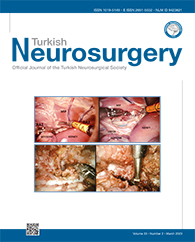2Medical Park Mersin Hospital, Department of Neurosurgery, Mersin, Turkey DOI : 10.5137/1019-5149.JTN.42533-22.2 AIM: To evaluate the effectiveness and outcomes of unilateral dynamic stabilization in patients with recurrent lumbar disc herniation (RLDH).
MATERIAL and METHODS: Patients requiring an operation due to RLDH at the L4?5 level were included in the study.They divided into the following two groups: SD group who had only revision discectomy (n=20) and DD group who had unilateral dynamic rod stabilization with discectomy (n=20). Low back and leg pain were evaluated with the visual analog scale (VAS), and functional results were evaluated with the Oswestry disability index (ODI). The VAS scores were evaluated in two different regions as VAS Low Back (VASLB) and VAS Leg (VASL). The results of each patient were evaluated preoperatively and at 1 and 12 months postoperatively. The anterior disc height (ADH), posterior disc height (PDH), and segmental angle (SA) were measured on the sagittal computed tomography (CT) scans of each patient?s lumbar spine. Modified Pfirrmann grades in the operated and adjacent segments on lumbar magnetic resonance imaging (MRI) were assessed preoperatively and at 12 months postoperatively.
RESULTS: A total of, 40 patients (17 women and 23 men; mean age, 47.9 years) were enrolled. There was no statistically significant difference in the VASLB scores between the two groups (p=0.42). The decrease in VASL scores was statistically significant between groups (p<0.05). A statistically significant decrease in ODI scores was also observed (p<0.05). When ADH and PDH obtained preoperatively and postoperatively were compared for the SD group, the differences were not statistically significant. Significant differences were found for ADH and PDH obtained preoperatively and postoperatively in the DD group (p<0.05). However, for SA, the difference was not significant between the two groups (p=0.28).
CONCLUSION: Unilateral dynamic stabilization for RLDH leads to fewer surgical complications and provides sufficient stability by preserving segmental movements.
Keywords : Unilateral dynamic, stabilization, recurrent lumbar disc herniation, Dynamic rod




